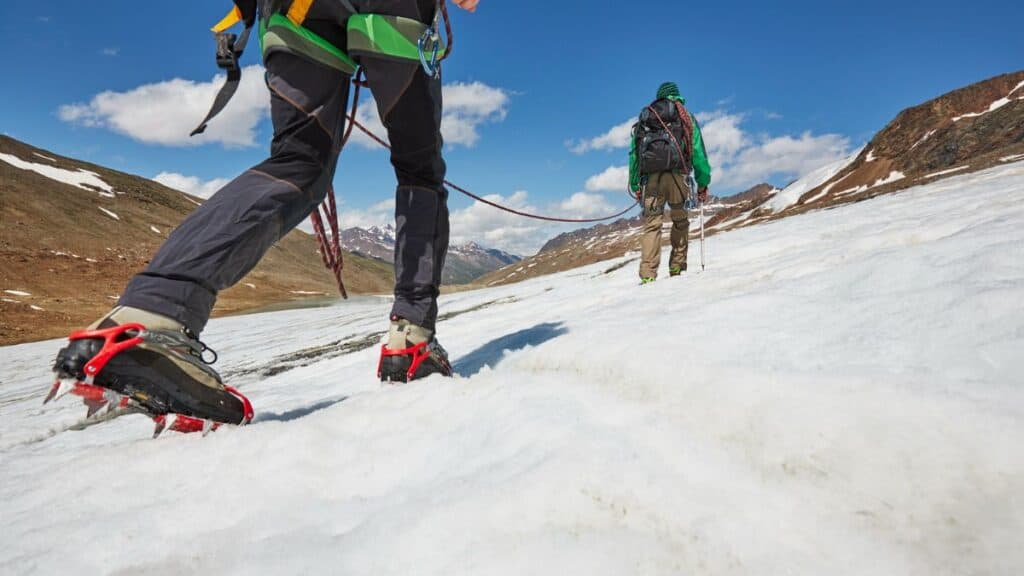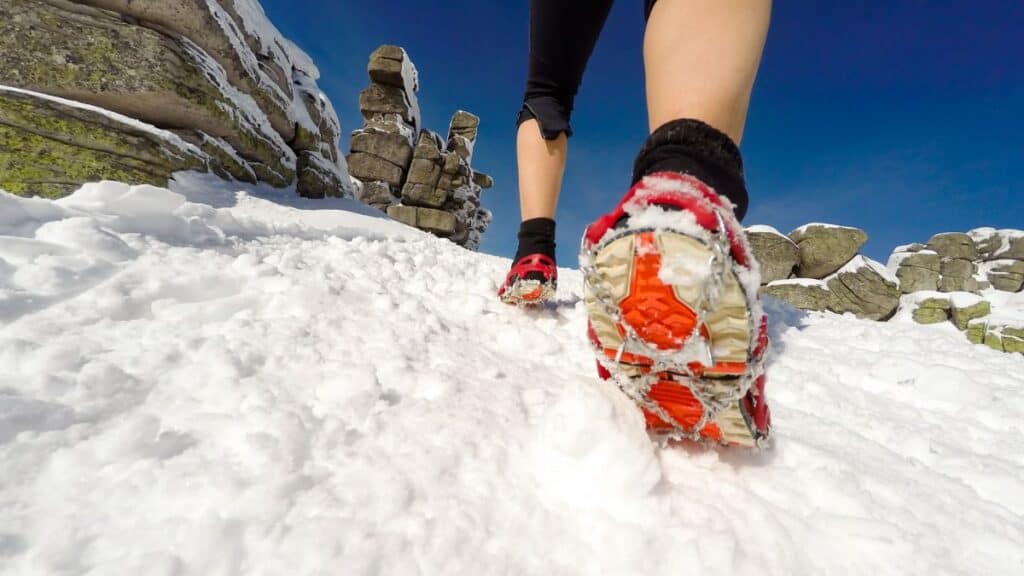
Curious to explore the world of icy terrains and conquer winter’s challenges? Before embarking on your frosty escapades, it’s crucial to understand the fundamental difference between two indispensable tools: crampons and microspikes.
Crampons are more robust and suitable for technical mountaineering, featuring longer, sharper spikes and a rigid frame, while microspikes are lightweight and versatile, with shorter, less aggressive spikes, primarily intended for non-technical winter activities such as hiking or running on icy surfaces.
In this captivating blog post, we’ll unravel the contrasting features of these traction devices, empowering you to choose the perfect companion for your frosty adventures and ensuring you stay one step ahead of winter’s icy grasp.
What are Crampons?
Crampons are a type of traction device that is attached to the bottom of boots to provide a better grip on snow and ice. They are designed for use in mountaineering, ice climbing, and other activities that involve traveling on steep, icy terrain.
Crampons typically have a metal frame with spikes or teeth that dig into the ice or snow. The spikes can vary in length and shape depending on the intended use.
Some crampons have horizontal front points that are designed for use on steep ice, while others have vertical front points that are better suited for mixed terrain.
Crampons can be categorized into two main types: step-in and strap-on. Step-in crampons are designed to be used with boots that have a compatible toe and heel welt.
The crampon is attached to the boot by sliding the toe bail into the front of the welt and then snapping the heel lever into place. Strap-on crampons, on the other hand, use straps to secure the device to the boot.
Crampons come in a range of sizes and styles, each designed for a specific type of activity. Some crampons are designed for general mountaineering, while others are designed for technical ice climbing.
It is important to choose the right type of crampon for the intended activity to ensure maximum safety and performance.
Types of Crampons
Crampons are essential tools for mountaineering and ice climbing. They provide traction and stability on icy and snowy terrain.
There are two main types of crampons: step-in crampons and strap-on crampons.
Step-In Crampons
Step-in crampons are designed to be used with mountaineering boots that have a toe welt and a heel welt. They have a wire bail that fits into the toe welt and a heel lever that fits into the heel welt.
The user steps into the crampon and secures it with a binding system that connects the crampon to the boot.
Step-in crampons are more secure than strap-on crampons and are ideal for technical climbing. They are also easier to put on and take off than strap-on crampons.
However, they are more expensive than strap-on crampons and require specific mountaineering boots that have toe and heel welts.
Strap-On Crampons
Strap-on crampons are designed to be used with any type of boot, including hiking boots and snowboard boots. They have straps that wrap around the boot and secure the crampon to the sole.
Strap-on crampons are less secure than step-in crampons and are not recommended for technical climbing. They are, however, more affordable than step-in crampons and can be used with any type of boot.
Strap-on crampons are also easier to adjust than step-in crampons, making them a good choice for beginners. They are also lighter and more compact than step-in crampons, making them a good choice for backpackers who want to save weight and space in their packs.
In summary, step-in crampons are more secure and better suited for technical climbing, while strap-on crampons are more versatile and better suited for general mountaineering and hiking.
The choice between the two types of crampons depends on the user’s needs and preferences.

What are Microspikes?
Microspikes are a type of traction device that hikers and mountaineers use to improve their grip on icy or snowy terrain. They are essentially small crampons that slip over the sole of a boot or shoe, providing extra traction on slippery surfaces.
Microspikes are designed for use on relatively flat terrain, such as meadow trails or gravel roads. They are not as aggressive as crampons, which are designed for steep, icy slopes.
Microspikes have 6-10 spikes that range in size from ¼ to ½ inches, and they are made with more chains and smaller spikes than crampons.
One of the advantages of microspikes is that they are much lighter and easier to use than crampons. They are also more affordable, with prices ranging from $50 to $75 per pair.
This makes them a popular choice for hikers who want to improve their traction on winter hikes without breaking the bank.
Microspikes are also small and easy to pack, making them a convenient addition to any winter hiking gear kit. They are also low maintenance, requiring only occasional cleaning and storage in a dry place.
Overall, microspikes are a great option for hikers and mountaineers who need extra traction on icy or snowy terrain but don’t want to invest in more expensive or aggressive traction devices like crampons.
Differences Between Crampons and Microspikes
When it comes to hiking or mountaineering on icy and slippery surfaces, traction is essential. Crampons and microspikes are two types of traction devices that can help hikers and mountaineers maintain stability and safety.
Although they may seem similar, there are some key differences between the two!
Design and Construction
Crampons are metal spikes that attach to the bottom of mountaineering boots. They typically have 10 to 12 points and come in different shapes and sizes.
Microspikes, on the other hand, are smaller and lighter than crampons. They are made of rubber or elastomer with small metal spikes attached to them.
Microspikes usually have 6 to 10 points and are designed to fit over regular hiking boots or trail shoes.
Intended Use
Crampons are designed for more technical mountaineering and ice climbing, where the terrain is steep and icy. They provide excellent traction on hard ice, snow, and mixed terrain.
Microspikes, on the other hand, are intended for hiking and walking on packed snow, icy trails, and moderate terrain. They are not suitable for steep or technical terrain.
Traction and Stability
Crampons provide better traction on steep and icy terrain than microspikes. They have longer and sharper points that can penetrate hard ice and snow.
Crampons also offer better lateral stability and support, which is crucial when traversing steep slopes.
Microspikes, on the other hand, provide moderate traction on packed snow and icy trails. They are not suitable for steep or technical terrain, as they can slip or bend under pressure.
Comfort and Flexibility
Crampons are heavier and bulkier than microspikes, which can make them uncomfortable for long hikes or approaches. They also require stiff mountaineering boots to attach to, which can limit flexibility and comfort.
Microspikes, on the other hand, are lightweight and flexible, which makes them more comfortable for long hikes or approaches. They can be easily attached to regular hiking boots or trail shoes, which provides more flexibility and comfort.
In summary, crampons and microspikes are two types of traction devices that can help hikers and mountaineers maintain stability and safety on icy and slippery terrain.
Crampons are designed for more technical mountaineering and ice climbing, while microspikes are intended for hiking and walking on packed snow, icy trails, and moderate terrain.
Crampons provide better traction and stability on steep and icy terrain, while microspikes offer moderate traction and flexibility on less technical terrain.
When to Use Crampons or Microspikes
Crampons and microspikes are both traction devices that are used for hiking or climbing on icy or snowy terrain. However, they are designed for different types of terrain and conditions.
Here are some guidelines on when to use crampons and microspikes:
Crampons
Crampons are best used on steep, icy terrain where you need to kick steps into the snow or ice. They are designed for mountaineering, ice climbing, and other activities where you need to climb up or down steep slopes.
Here are some conditions where you might want to use crampons:
- Steep slopes with hard-packed snow or ice
- Ice climbing
- Glacier travel
- Mixed rock and ice climbing
- Vertical ice climbing
Crampons are not recommended for use on flat or gentle terrain, as they can be uncomfortable to walk in and can damage the trail.
They are also not recommended for use on soft snow, as the spikes can sink in and provide less traction.
Microspikes
Microspikes are best used on flatter terrain with packed snow or ice. They are designed for hiking, trail running, and other activities where you need extra traction on snow or ice.
Here are some conditions where you might want to use microspikes:
- Flat or gently sloping terrain with packed snow or ice
- Trails with icy patches
- Snowy roads or sidewalks
- Winter trail running
Microspikes are not recommended for use on steep terrain, as they do not provide enough traction for kicking steps into the snow or ice. They are also not recommended for use on soft or deep snow, as the spikes can sink in and provide less traction.
In summary, choosing between crampons and microspikes depends on the terrain and conditions you will encounter. Crampons are best for steep, icy terrain, while microspikes are best for flatter terrain with packed snow or ice.
Always use the appropriate traction device for the conditions to ensure your safety and minimize damage to the trail.
Conclusion on crampons vs. microspikes
In summary, the main difference between crampons and microspikes is the terrain they are best suited for. Crampons are designed for steep and icy terrain, such as mountaineering or ice climbing, while microspikes are more suitable for flatter terrain, such as meadow trails or gravel roads.
Crampons are heavier and more expensive than microspikes, but they provide better traction on steep and icy terrain. Microspikes are lighter and more affordable, making them a great option for hikers who want to add some traction to their winter hikes without breaking the bank.
It is important to note that both crampons and microspikes require proper care and maintenance. After use, they should be dried for 4-6 hours in a warm place and occasionally oiled with machine oil to keep the spikes from rusting.
When deciding between crampons and microspikes, it is important to consider the specific terrain and conditions of your hike. If you are planning to hike on steep and icy terrain, crampons are a must-have. If you are hiking on flatter terrain, microspikes can provide the necessary traction without adding unnecessary weight to your pack.
Ultimately, the choice between crampons and microspikes comes down to personal preference and the specific needs of your hike.
By understanding the differences between these two types of traction devices, hikers can make an informed decision and enjoy a safe and enjoyable winter hiking experience.
If you found this article helpful, make sure to take a look at my related microspike articles linked below!
